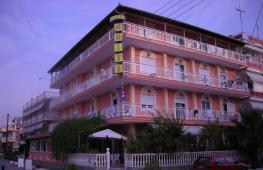Painted rocker. A painted yoke hung over the river
The sun came out
From a furry cloud,
Reached out for the rain
Fingers - rays.
But the rain did not chicken out.
He didn’t part with us,
Seven-colored rainbow
Remained above ground.
Muggles know how to invent trouble for themselves! Look here:
« A rainbow is an atmospheric optical and meteorological phenomenon, usually observed in a field of high humidity. It looks like a multi-colored arc or circle made up of the colors of the spectrum (looking from the outside - inside the arc: red, orange, yellow, green, blue, indigo, violet). These seven colors are the main names of colors that are usually identified in the rainbow in Russian culture (perhaps following Newton), but it should be borne in mind that in fact the spectrum is continuous, and these colors in the rainbow transform into each other with a smooth change through many intermediate shades.
The center of the circle described by a rainbow lies on a straight line passing through the observer and the Sun, moreover, when observing a rainbow (unlike a halo), the Sun is always behind the observer, and it is impossible to simultaneously see the Sun and the rainbow without the use of optical devices. For an observer on the ground, a rainbow usually looks like an arc, part of a circle, and the higher the observer’s point of view, the more complete the rainbow (from a mountain or an airplane you can see a full circle). When the Sun rises above 43 degrees above the horizon, the rainbow is not visible from the Earth's surface»
After all, a rainbow is a real miracle! And they call it an atmospheric optical and meteorological phenomenon!
There are many myths and signs associated with the rainbow.
One legend tells how one day a rainbow fell into pieces before disappearing. Wonderful fragments of the rainbow fell to the ground and charming flowers sprouted. The rainbow crumbled into small fragments - and the irises bloomed.
In the biblical tradition, a rainbow is a sign of God in the heavens, placed there after the Flood as a promise that the world will never again be destroyed by water. Pagan myths saw it as a spirit (in Burma and among the Zulus - a dangerous demon), or a weapon of the gods, or a bridge for souls. In India, as well as in Finland, it was a bow from which the thunder god threw his lightning arrows. In ancient Scandinavia it was Bifrost, a bridge built by Odin between Midgard, the abode of people, and Asgard, the home of the gods. The souls of the dead passed through it, if they were worthy of it, but if not, they were devoured by a fierce flame - the same thing that we, living here below, see as a red stripe in a rainbow. Long after the victory of Christianity, this idea persisted in the German-Austrian legend that souls, especially the souls of children, walk along the rainbow to heaven, accompanied by their guardian angel.
In Ireland they say that if you find the place where the rainbow hits the ground, you will find a pot of gold.
Even today people judge the weather by the time the rainbow appears and its appearance. “A rainbow in the morning is a warning to shepherds,” no less than a red morning sky, and “a rainbow in the evening - rain has nothing to do with it.” This is often justified because the weather usually moves from west to east, and the morning rainbow shows the approach of rain from the west, and the evening rainbow that it has already gone to the east. Pieces of rainbows appearing in the clouds, sometimes called “wind dogs” or “weather gulls,” predict the onset of stormy weather with gusty winds.
There is a rainbow in China - sky Dragon, the union of Heaven and Earth, a sign of the unification of yin and yang.
In Ancient India, a rainbow is the bow of Indra, the thunder god; in addition, in Hinduism and Buddhism, the “rainbow body” is the highest yogic state attainable in the realm of samsara.
In Islam, the rainbow consists of four colors - red, yellow, green and blue, corresponding to the four elements.
In some African myths, a celestial serpent is identified with a rainbow, which serves as a guardian of treasures or envelops the Earth in a ring.
American Indians identify the rainbow with a ladder that can be used to climb to another world. Among the Incas, the rainbow was associated with the sacred Sun, and the Inca rulers wore its image on their coats of arms and emblems.
Among the Chibcha-Muisca Indians, the rainbow was considered a good deity. In specific mountain conditions Amazing sights in the Cordillera a natural phenomenon: against the background of a foggy haze, a rainbow sometimes appears, as if framing a many times enlarged reflection of the observer himself. The main sanctuary dedicated to the goddess of the Rainbow, Chibcha, was erected next to the Tekendama mountain waterfall, where the brightest arc always lights up as soon as the rays of the sun hit the water splashes.
In Scandinavian mythology, "Bivrest" ("shaking road", "trembling path") is a rainbow bridge connecting heaven and earth. He is guarded by the guardian of the gods, Heimdall. Before the end of the world and the death of the gods, the bridge collapses.
IN Ancient Greece the goddess of the rainbow was the virgin Iris, the messenger of the gods, the daughter of Thaumant and the oceanid Electra, the sister of the harpies. She was depicted with wings and a caduceus. Her robe is made up of dew drops that shimmer in the colors of the rainbow.
The Western Slavs have a belief that a witch can steal a rainbow and hide it, which means causing a drought on the earth.
Seeing a rainbow is a good omen, and many people make a wish at the same time. Pointing your finger at it is very bad, otherwise some misfortune or failure will befall you, the least that can happen from this is that it will rain again. Children in the northern regions often “cross out” it by making a cross on the ground from twigs or straws with small stones at the ends. This is expected to make the rainbow disappear, although few children can say why it bothers them. Perhaps this custom is based on vague memories of the ancient concept of it as a bridge of souls.
Rainbow signs:
Tall and steep rainbow to the bucket; flat and low - to bad weather.
If a rainbow soon disappears after rain, it means clear weather, and if it lasts for a long time, it means bad weather.
Rainbow in the morning - for rain.
A double rainbow is a sign of rainy weather.
If a steep rainbow appears in the evening, it will be an equally clear day, but if it is flat, expect rain from the night.
Green rainbow for rain, yellow for good weather, red for heat and wind. When they see a rainbow, they expect a change in the weather.
Swimming on the water when a rainbow appears is dangerous - it can drag you to the sky.
The red yoke hung across the river.
A painted yoke hung across the river.
Painted rocker
It hung over the river.
For a minute, a multi-colored miracle bridge grew into the ground.
The miracle worker made a high bridge without railings.
The gates rose -
There is beauty all over the world.
The gates have risen, beauty to the whole world.
The sun ordered: “Stop, the seven-colored bridge is steep!”
The cloud hid the light of the sun. The bridge collapsed - and there are no chips!
It happens after the rain
covers half the sky.
The arc is beautiful, colorful
It will appear, then melt away.
The sun ordered: "Stop,
The Seven Color Bridge is cool!"
A cloud hid the sun's light -
The bridge collapsed, but there were no chips.
Multi-colored rocker
It hung over the river.
The golden bridge spreads
Seven villages, seven miles.
Through the fields
Through the meadows
An elegant arc emerged.
What a wonderful beauty!
painted gate
Showed up on the way!..
You can't drive into them,
Neither log in
What a miracle: the fruit spits -
It is not given to the whole person.
Squirting cucumber
To light the stove,
We need to get some wood.
Where will we go for them?
On..., for dry ones!
Deadwood
What will be born in the bread,
Is it not good for food?
Bright blue and fluffy
It is born in bread, but is not suitable for food.
Everyone knows us:
Bright as a flame
We are namesakes
With small nails.
Admire the wild
Scarlet...
Carnations
The green house is cramped:
Narrow, long, smooth.
They sit side by side in the house
Round guys.
In the autumn trouble came -
The smooth house is cracked,
We galloped in all directions
Round guys.
Small, green house
Was in Lyusenka's hands.
Split and fell
Beads on her palm.
The cramped house split
In two halves
And fell into the palms
Beads - pellets.
Peas, Bean
Black, little baby,
They'll collect a little
They will cook in the water,
Whoever eats it will praise it.
Stands above the water
Shakes his beard.
The little blue bell is hanging,
He never calls.
Bell
Eh, bells, blue color,
With a tongue, but no ringing.
Bells
A house grew up in a field -
The house is full of grain.
The walls are gilded
The shutters are boarded up.
And there is a new house
On a gold pillar.
Olya is worth it
In the middle of the field
She covered herself with a tent,
She propped herself up with a spear.
They didn’t dig, they didn’t drill, but they got water
Jugs and saucers
And they don’t drown and don’t fight.
Water lilies
In these yellow pyramids
Hundreds of delicious grains.
Corn
White peas
On a green leg.
White peas on a green stem.
The plant is visible,
And the name is offensive.
The head is on a leg, there are polka dots in the head.
The sun is burning the top of my head,
He wants to make a rattle.
These red flowers
They will lose their petals.
The petals will lose
Will turn into chests
And what do the chests hide?
It will end up on pies.
Yellow chicks
On a green branch
Dads give it to mommy,
And boys - girls.
In the field - earrings
On thin legs.
Like in a field on a mound
There is a chicken with earrings.
Like on a field, on a mound
There is a chicken with earrings.
We became friends with him a long time ago,
He gives cereals and oatmeal,
And flour, and porridge, and cookies...
Let's thank him for the treat.
Oats, Podzernovka
To correctly complete the building, you should understand what spellings of weak positions are.
Mistakes are often made in spelling due to ignorance of spelling rules.
Spelling in Greek means "correct letter." This is where the science that studies all spelling patterns and rules of the Russian language - spelling - takes its origins. Spelling must comply with the spelling rules of the native language.
Spelling of weak positions occurs when it is not clear which letter should be written.
At school, it is customary to underline the required spelling with one line, and the adjacent identifying features with two lines.
Choosing the correct spelling
We write letters according to their pronunciation. As we hear, so we write. This choice is called phonetic.
The Russian language contains words borrowed from the languages of other countries. We write these words according to the principle of differentiation.
The traditional method is applicable if the spelling is difficult to determine. Such words are written according to tradition.
When all morphemes in a word are written the same way, this principle is called morphological.
Spelling patterns can be located in different parts of a word. If you correctly denote spelling and know the rules of spelling, you will become literate people.
Let's write down the riddles, skipping the spellings of weak positions
A beautiful k_r_thought appeared across the river. No ears, but he can hear, no mouth, but he cries, no mind, but knows all languages.
Our assignment contains the following rules of the Russian language: spelling of the unstressed vowel at the root of the word (yoke, tongues, screams) and spelling of the vowel after the letter “sh” (painted, ears, hears).
To correctly write a word with an unstressed vowel in the root, you need to change the required word so that the desired vowel is stressed.
After the hissing letter "sh" they write:
- letters –i, -a, -u. Except for the words: jury, parachute, brochure;
- the letter –е is in the root of a word if it is under stress and the stress is movable. Also in the case when -е alternates with the letter -e;
- the letter –o is at the root of a word if the stress is constant.



